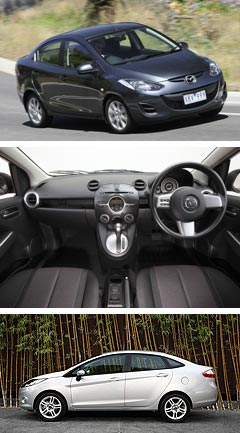Mazda2 sedan goes missing in production switch
BY RON HAMMERTON | 27th Jan 2011

The Mazda move is designed to free up production space to meet burgeoning demand for the baby of the Mazda range in South East Asia and take pressure off the Thai plant that not only makes the popular Mazda2 five-door hatchback and sedan range but matching Ford Fiesta models from the same platform.
Now, Mazda Australia will sell only the five-door hatchback version, because the sedan is not available from the Hiroshima plant.
The five-door Mazda2 already makes up 90 per cent of the model’s volume in this country, where the Mazda2 was the third biggest seller in the light-car category after the Toyota Yaris and Hyundai Getz in 2010.
Mazda Australia managing director Doug Dickson said: “With the increasing demand for Mazda2, securing supply was extremely important.
“Now that production of Australian-bound Mazda2s has moved back to Hiroshima, we can be sure of fulfilling customer demand and maintaining momentum in the light car segment.”Ford Australia confirmed that it will continue to source its Fiesta sedan and hatchback from the Thai plant, meaning the Ford variants also still get the benefit of the five per cent import duty cut afforded by Australia’s free-trade agreement with Thailand.

However, Mazda Australia says that despite the fact that the Mazda2 will now attract an import tariff, the company will hold the price of the Japanese stocks to the same level as the Thai-built cars, including special promotional driveaway pricing on Mazda Neo and Maxx ($16,990 and $19,990 for manual variants respectively).
Mazda Australia public relations manager Steve Maciver told GoAuto that the loss of the sedan variant was not expected to hurt Mazda2 sales in Australia, where the sedan accounted for 10 per cent of volume since it was introduced with Thai production in May last year.
“We are pretty confident the customers who are in the market for Mazda2 were not necessarily buying a sedan because it was a sedan,” he said.
“We believe the Mazda2 nameplate is what it has attracted them to that particular product.”Mr Maciver said that when Mazda Australia had started sourcing Mazda2 from Thailand last year, it had expected to continue that arrangement.
However, he said that now that the decision had been made to switch back to Japanese supply, it was expected to stay that way.
Mr Maciver said Mazda Australia had not considered sourcing just the Mazda2 sedan from the Thai plant, alongside the Japanese-made hatchback.
“It is not something we have looked at,” he said. “From our point of view, it is our preference for the one model line to all come out of the one factory.” Mr Maciver said the decision to make the supply switch had nothing to do with Australian sales of the car, nor with a lack of supply to date.
He said the move was wholly to do with freeing up production space to allow further sales growth in countries such as Thailand, where the local Mazda branch sold 25,000 units last year.
Mr Maciver said Mazda Australia was not concerned that Ford would continue to receive its four-door Fiesta while its own would be discontinued.
“At the end of the day, we can only worry about what we can do, as a company,” he said.
“We have made the decision that we are happy with – the move back to Hiroshima – and that the five-door hatch is the right core product for Mazda2.
“So that is what we are going to do. We are not overly concerned that Ford is going to have a sedan and we are not.”Mr Maciver said Mazda had no plans to source its top-selling Mazda3 from Thailand, and it too would continue to come from Hiroshima indefinitely, even though Ford has confirmed plans to move Focus production to Thailand within the life of the new model that is set to touch down in Australia late this year.
The only Mazda model now slated for Thai production for Australia is the BT-50 light truck, which is ramping up for a major model change this year.
Deliveries of Japanese-made Mazda2 hatches have already arrived in Australia from Hiroshima, moving out to showrooms to replace stocks supplied from Thailand since May last year.
The new cars benefit from a minor facelift that was introduced on Japanese-made cars last year after being unveiled at the Paris motor show in August.
The Mazda2 Neo hatch gets new 15-inch steel wheels, body coloured exterior door handles, fresh seat trim and piano black interior finishes. The Maxx also gets the new interior trim with the piano black highlights, while both models are available in two new colours: Aquatic Blue and Burgundy Red.
An upgraded top-of-the-range Genki hatch will arrive mid year, when details will be announced.
Mazda’s revised hatchback is powered by the same 1.5-litre 76kW petrol engine across the range.
Ford’s rival Fiesta comes with a bigger 1.6-litre 88kW four-cylinder petrol engine or optional 1.6-litre 66kW diesel.